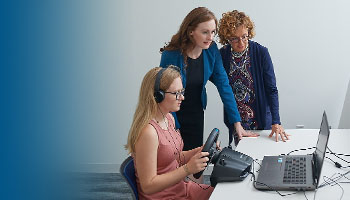HOW CAN WE HELP YOU? Call 1-800-TRY-CHOP
In This Section
New Study Shows Virtual Driving Assessments Feasible for New Drivers

Virtual driving assessments can predict who might fail their road tests.
shafere1 [at] email.chop.edu (By Emily Shafer)
Teenagers can test their driving skills virtually and get an idea of not only whether they’ll pass the test, but also whether they have the skills needed to avoid crashes, thanks to new research from the Center for Injury Research and Prevention (CIRP) at Children’s Hospital of Philadelphia that demonstrates the feasibility of adding virtual driving assessments to the driver’s licensing process.
The virtual driving assessment system accurately predicted drivers who would fail the road test, and it provided feedback to the drivers on their skill deficits. The findings appeared in Health Affairs.
A partnership of CHOP researchers, Ohio Bureau of Motor Vehicles officials, and Diagnostic Driving Inc. founders — a CHOP spinout company that developed the virtual driving assessment program — conducted the pilot study in Ohio, which passed legislation in 2015 to provide funds to use simulated driving assessments as part of the licensing process.
“The success of these partnerships demonstrates the effectiveness of the innovative work being done to keep children safe,” said Flaura K. Winston, MD, PhD, CIRP founder and scientific director, a founder of Diagnostic Driving, and co-author of the analysis. “We believe the work we have done in Ohio could serve as a foundational model for the future of driving safety, where virtual assessments at the time of licensure provide applicants with personalized feedback on how to improve driving skills needed to avoid crashes and are a gold standard in preparing adolescents for safe driving.”
Data collection began in July 2017. Driver's license applicants underwent the virtual driving assessment immediately before their scheduled on-road examination. Based on 4,643 pairs of virtual assessment and road tests conducted by the Ohio Bureau of Motor Vehicles, Dr. Winston and her team found that the technology was valid, feasible, and efficient. In addition, license applicants reported that the virtual driving assessment system was easy to use, realistic and representative of their on-road driving.
“This partnership has shown that implementing a successful intervention for improving driver safety can be widely deployed and remain cost-effective,” said Elizabeth Walshe, PhD, research scientist at CIRP, a fellow at the Annenberg Public Policy Center of the University of Pennsylvania, and co-author of the analysis. “Translational research is still needed to improve how we can truly help as many adolescents as possible prepare, but the strength of this program has established a road map for us to know where that research needs to go.”
The report also highlights how the COVID-19 pandemic has led to the need for virtual driving assessments in the future. Although states adopted a variety of strategies to accommodate social distancing, many of the strategies implemented involved less exposure to situations that could assess critical safe driving skills during a modified driving exam.
The authors recommend the following immediate, short-term, and longer-term opportunities for virtual driving assessment:
- as a complete replacement for or in conjunction with the limited road testing due to contact restrictions during the current or future emergent situations (e.g., COVID-19 pandemic)
- as a screening/pre-test model to identify underprepared drivers and to ensure consistency in evaluations (e.g., with third-party testing)
- as a strategy for providing systematic feedback and coaching regarding safe driving skill deficits to the applicant, the applicant’s family and their driving school.
The time when adolescents are getting their driver’s licenses is a critical point for a safety intervention aimed at reducing risk and ultimately preventing crashes. Motor vehicle crashes accounted for one in five deaths in adolescents age 16 to 19 in 2018, making them the leading cause of death and injury in this age group.
See the press release for more details on the report published in Health Affairs.